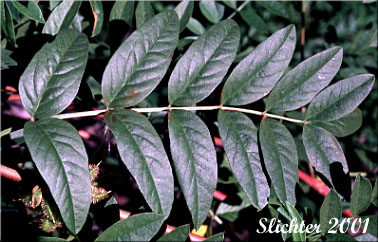Licorice root is a small, aromatic shrub with a cluster of several stout stems arising 30-150 cm high from many deep, woody, horizontal rhizomes. The stems are typically covered with tiny scales and raised glands. The leaves measure from 7-15 cm long and are pinnately compound (See photo below.) with 7-19 lanceolate to oblong leaflets, each ranging from 2-4 cm in length. The have acute tips and bases and are covered with glands.
The flower stems are shorter than the leaves. The numerous flowers are found in dense, short racemes of many flowers. The calyx measures 6-7 mm long and has 5 awl-shaped teeth. The yellowish-white corollas range from 10-15 mm long. The pods are 10-20 mm long with numerous, hooked-prickly spines measuring 4-5 mm long covering their surfaces (similar to a cocklebur (See photo below.).

var. glutinosa: Stalked glands may be found throughout the inflorescence and often ont he petioles, and main stems. This variety is found east of the Cascade Mts. from British Columbia south to California and east to Yellowstone National Park.
var. lepidota: Stalked glands may be found on the calyx. This variety may be found from Montana east to Ontario, and south to California. It is uncommonly found in Idaho and Washington.
Licorice root may be found in waste areas or in low ground just above streams and rivers.
Licorice root may be found from British Columbia south to California and east to Ontario, Minnesota, Arkansas, New Mexico, Arizona, and Texas.
In the Columbia River Gorge, it may be found between the elevations of 0'-300' throughout the length of the Gorge.